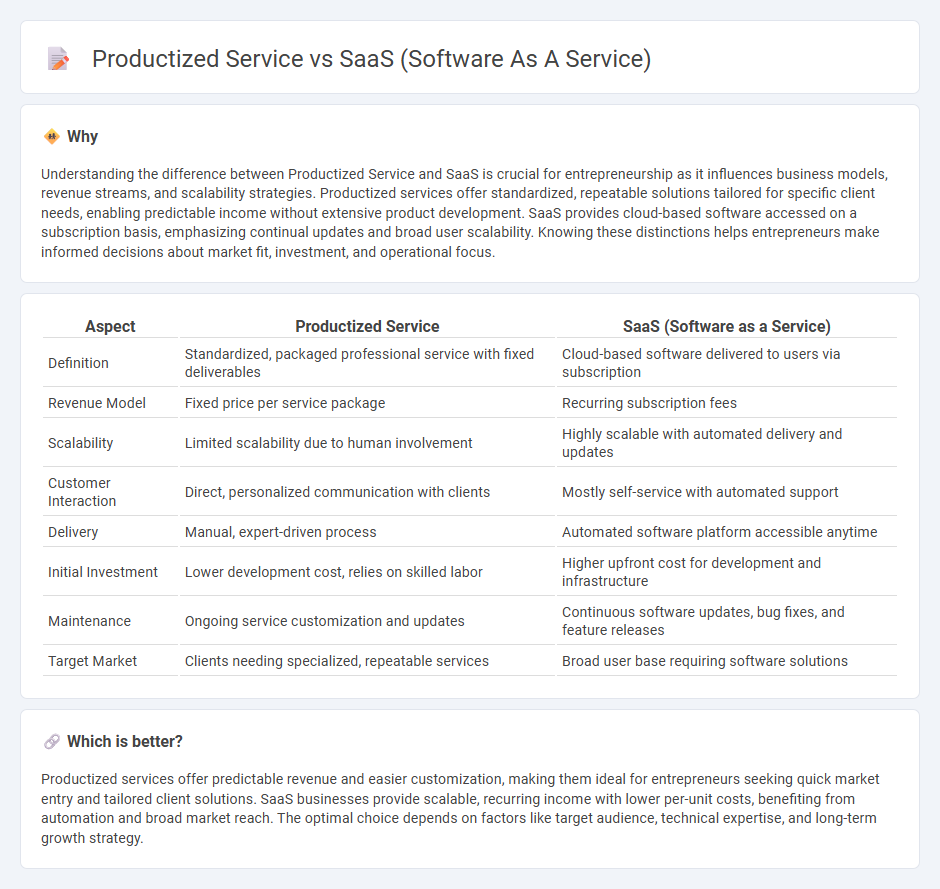
Productized services offer predefined, scalable solutions that provide predictable outcomes without extensive customization, making them ideal for entrepreneurs seeking streamlined operations. SaaS (Software as a Service) delivers cloud-based software products with subscription models that enable continuous updates and flexible access for users worldwide. Explore the key differences and benefits of productized services versus SaaS to determine the best fit for your entrepreneurial strategy.
Why it is important
Understanding the difference between Productized Service and SaaS is crucial for entrepreneurship as it influences business models, revenue streams, and scalability strategies. Productized services offer standardized, repeatable solutions tailored for specific client needs, enabling predictable income without extensive product development. SaaS provides cloud-based software accessed on a subscription basis, emphasizing continual updates and broad user scalability. Knowing these distinctions helps entrepreneurs make informed decisions about market fit, investment, and operational focus.
Comparison Table
| Aspect | Productized Service | SaaS (Software as a Service) |
|---|---|---|
| Definition | Standardized, packaged professional service with fixed deliverables | Cloud-based software delivered to users via subscription |
| Revenue Model | Fixed price per service package | Recurring subscription fees |
| Scalability | Limited scalability due to human involvement | Highly scalable with automated delivery and updates |
| Customer Interaction | Direct, personalized communication with clients | Mostly self-service with automated support |
| Delivery | Manual, expert-driven process | Automated software platform accessible anytime |
| Initial Investment | Lower development cost, relies on skilled labor | Higher upfront cost for development and infrastructure |
| Maintenance | Ongoing service customization and updates | Continuous software updates, bug fixes, and feature releases |
| Target Market | Clients needing specialized, repeatable services | Broad user base requiring software solutions |
Which is better?
Productized services offer predictable revenue and easier customization, making them ideal for entrepreneurs seeking quick market entry and tailored client solutions. SaaS businesses provide scalable, recurring income with lower per-unit costs, benefiting from automation and broad market reach. The optimal choice depends on factors like target audience, technical expertise, and long-term growth strategy.
Connection
Productized services streamline recurring tasks into standardized offerings, enhancing scalability and predictability for entrepreneurs. SaaS (Software as a Service) platforms often embody productized service principles by delivering software solutions through subscription models with fixed features and pricing. This connection enables entrepreneurs to efficiently scale operations, reduce customization costs, and improve customer retention through consistent service delivery.
Key Terms
Scalability
SaaS solutions inherently offer greater scalability by leveraging cloud infrastructure to serve numerous customers with minimal incremental cost, while productized services often require proportional increases in human resources as demand grows. The automation and standardized delivery in SaaS enable rapid expansion across markets without significant operational bottlenecks. Explore detailed comparisons to understand which model best aligns with your business scalability goals.
Revenue Model
SaaS operates on a subscription-based revenue model, generating consistent monthly or annual income by providing cloud-hosted software access, while productized services charge a fixed fee for standardized, repeatable solutions often delivered on a project basis. SaaS benefits from scalability and recurring revenue, making it attractive for long-term customer retention, whereas productized services offer clear, upfront pricing that appeals to clients looking for predictable costs without ongoing commitments. Explore detailed comparisons of revenue optimization strategies between SaaS and productized services to identify the best approach for your business goals.
Customer Onboarding
Customer onboarding in SaaS (Software as a Service) typically leverages automated workflows and self-service portals to streamline user adoption, reducing time-to-value and minimizing manual intervention. In contrast, productized services emphasize personalized support and tailored onboarding processes, enhancing customer satisfaction through human interaction and customization. Explore deeper insights on optimizing customer onboarding strategies for both SaaS and productized services to boost retention and engagement.
Source and External Links
Software as a service - Wikipedia - SaaS is a cloud computing service model offering application software remotely via the web, managed by the provider on shared infrastructure, and accessed typically by subscription without owning the software itself.
What is SaaS (Software as a Service)? | Salesforce US - SaaS delivers applications over the internet, removing the need for local installation and maintenance, enabling easier collaboration and scalable access to software as a service rather than a product.
What is SaaS (Software as a Service) - Oracle - SaaS is a cloud-based delivery model where software is developed, maintained, updated by providers, accessed via the internet on a pay-as-you-go basis, supporting rapid scaling and lowering costs for businesses.
 dowidth.com
dowidth.com